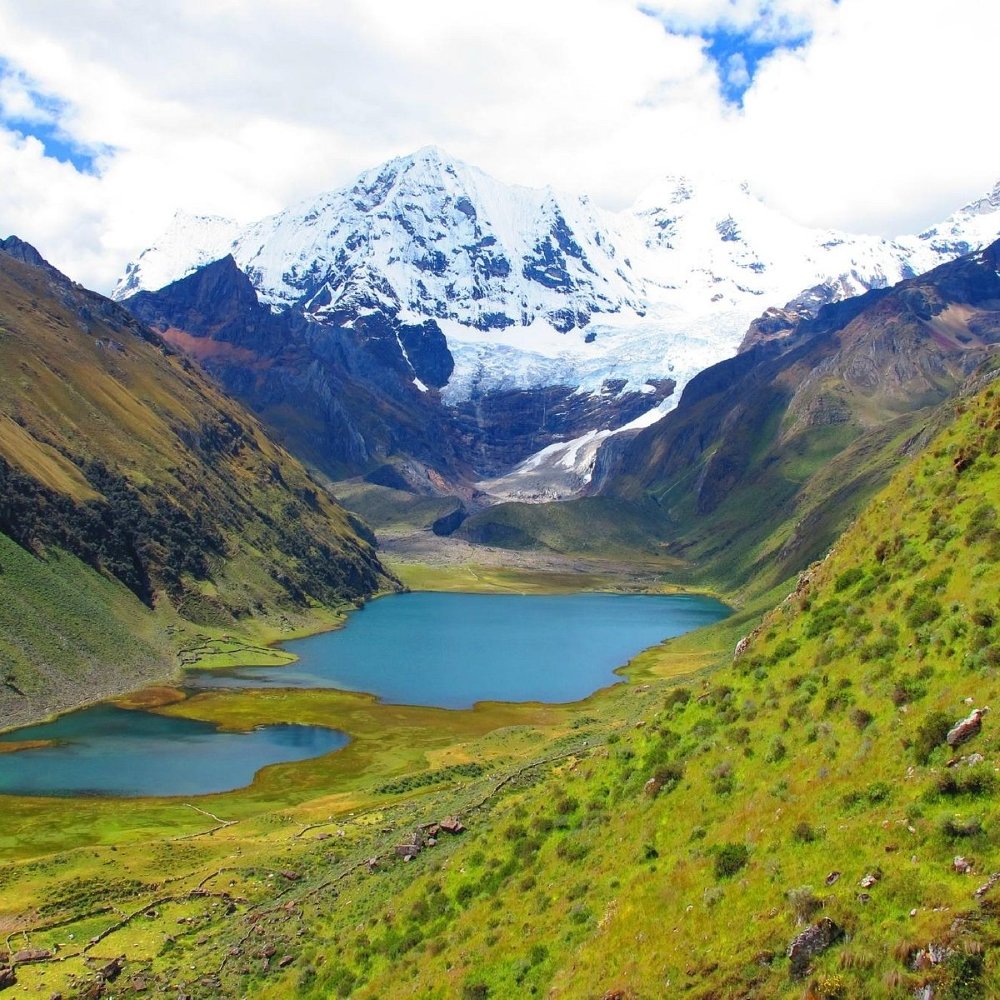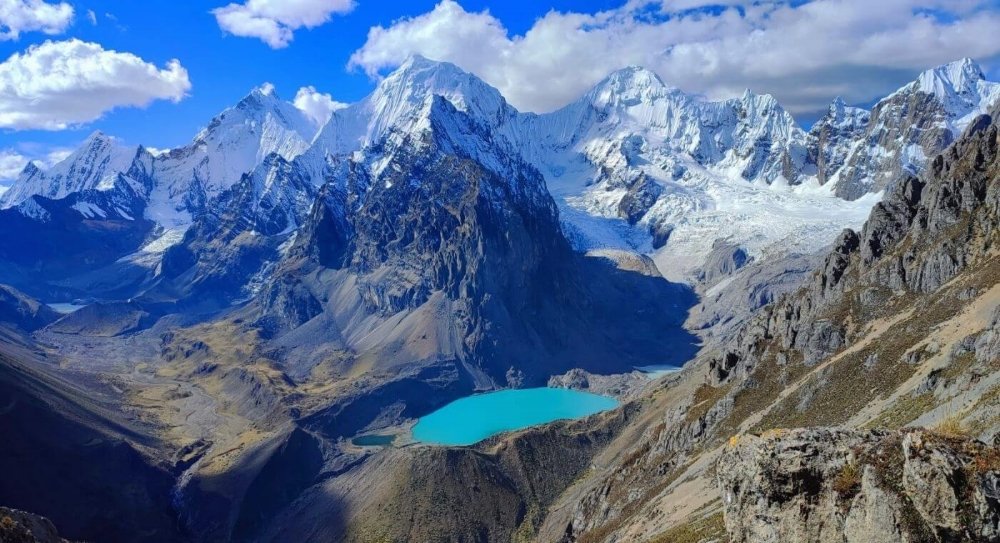Huayhuash Mountain Range | Ancash
The Cordillera Huayhuash | Ancash is an impressive mountain range located in the Ancash region of north-central Peru. Known for its snow-capped peaks, deep valleys and turquoise lakes, the Huayhuash is a popular destination for hikers and nature lovers looking to explore the spectacular scenery of the Peruvian Andes.
This mountain range is home to some of Peru’s highest mountains, including Yerupajá, the second highest peak in the country. In addition to its natural beauty, the Huayhuash is also inhabited by local communities that preserve their ancestral traditions and traditional lifestyles.
Visitors can enjoy a variety of activities in the Cordillera Huayhuash, such as trekking, climbing, bird watching and landscape photography. With its breathtaking panoramic views and unique natural environment, the Huayhuash offers an unforgettable experience for those seeking outdoor adventure in the Peruvian Andes.
Location
The Cordillera Huayhuash is located in the region of Ancash, in north-central Peru. This mountain range extends approximately between geographic coordinates 10°18′ and 10°50′ south latitude, and between 76°42′ and 77°18′ west longitude.
Within the Ancash region, the Cordillera Huayhuash encompasses an extensive mountainous area that includes snow-capped peaks, deep valleys and mountain lakes. Its location in the Peruvian Andes makes it a popular destination for hikers and nature lovers looking to explore the breathtaking landscapes of this region.
How to get there?
To get to the Cordillera Huayhuash in the Ancash region of Peru, you generally follow a route from the city of Huaraz, which is the closest city and a common starting point for those visiting this mountainous area. Here are some options to get there:
- By road from Lima: The most common way to reach Huaraz from the Peruvian capital, Lima, is via a road trip. The journey can take approximately 8 to 10 hours, depending on traffic and road conditions. Buses can be taken from Lima’s Terminal Terrestre to Huaraz.
- By plane: Another option is to take a flight from Lima to Comandante FAP Germán Arias Graziani Airport in Huaraz. However, flights to Huaraz are less frequent and may be subject to cancellations due to weather conditions and the topography of the region.
Once in Huaraz, you can organize your trip to the Cordillera Huayhuash in several ways:
- Hire a local tour operator that offers excursions and trekking in the Cordillera Huayhuash.
- Rent a private vehicle and hire a local guide to take you to the mountain range.
Take a bus from Huaraz to the start of the trails in the Cordillera Huayhuash, such as - the town of Llamac, and then continue on foot.
It is important to research and plan your trip in advance, as well as inform yourself about weather conditions and the equipment and preparation requirements needed to explore the Cordillera Huayhuash safely.
What activities can I do in the Huayhuash Mountain Range | Ancash?
- Trekking and hiking: The Huayhuash is famous for its spectacular trekking routes through deep valleys, crystal clear lagoons and breathtaking mountain passes. The trekking circuit around the Cordillera Huayhuash is one of the most spectacular treks in the world and attracts hikers from all over the world.
- Mountain climbing: For the more adventurous and experienced, the Cordillera Huayhuash offers numerous opportunities for mountain climbing. With peaks over 6,000 meters high, such as Yerupajá, the second highest peak in Peru, the mountain range is a climber’s paradise.
- Observation of flora and fauna: The Huayhuash is home to a great diversity of wildlife, including birds, mammals and plants. Nature lovers can enjoy watching condors, vicuñas, foxes and a variety of birds while exploring the mountain range.
- Photography: The spectacular landscapes of the Cordillera Huayhuash offer countless opportunities for landscape photography. From snow-capped peaks to turquoise lagoons and green valleys, every corner of the range is a natural masterpiece.
- Cultural interaction: The Cordillera is inhabited by local communities that preserve their ancestral traditions and traditional lifestyles. Visitors can have the opportunity to learn about the culture and way of life of these communities, as well as support them by purchasing local handicrafts.
- Camping and outdoor life: Camping under the stars in the Cordillera Huayhuash is an unforgettable experience. There are numerous campsites and camping areas along the trekking routes where visitors can spend the night and enjoy the tranquility and beauty of nature.
History of Huayhuash Mountain Range | Ancash
The history of the Cordillera Huayhuash is closely linked to the history and culture of the communities that have inhabited this region of the Peruvian Andes for millennia. Although there are no precise written records of the early history of the Cordillera, it is believed that indigenous populations, such as the Quechua and Huaylas, have occupied these lands since ancient times, depending on the region’s natural resources for their subsistence.
During the Inca period, the Cordillera Huayhuash was part of the vast Inca empire, and the Incas built roads and established settlements in the highlands of the Andes, including this mountain range. It is believed that the Incas considered the Cordillera Huayhuash sacred and divine, and the region was revered for its natural beauty and spiritual importance.
With the arrival of the Spanish and the conquest of the Inca empire in the 16th century, the Cordillera Huayhuash underwent important changes in its social, economic and cultural structure. The Spaniards imposed new forms of organization and religion, but many of the indigenous traditions and beliefs persisted, adapting to the new circumstances.
In more recent times, the Cordillera Huayhuash has been the scene of numerous mountaineering and adventure expeditions, attracting climbers and hikers from all over the world who seek to challenge its snow-capped peaks and explore its breathtaking landscapes. The range is also home to local communities that continue to live according to ancestral traditions and practice traditional ways of life.
Today, the Cordillera Huayhuash is valued as much for its cultural and historical importance as for its breathtaking natural beauty. It is a popular destination for ecotourism and adventure tourism, offering a variety of outdoor activities and cultural experiences for visitors who wish to explore the Peruvian Andes and immerse themselves in the rich heritage of this mountainous region.
Recommendations
- Physical preparation: Before undertaking any activity in the Cordillera Huayhuash, make sure you are in good physical shape, especially if you plan on trekking or mountain climbing. The altitude and mountainous terrain can be challenging, so it is important to be physically prepared.
- Proper equipment: Wear clothing and footwear suitable for outdoor activities in the mountains. This includes warm, waterproof and sturdy clothing, as well as comfortable hiking boots and a hat to protect you from the sun.
- Hydration and nutrition: Bring enough water and food for your hike, as it can be difficult to find outlets in the mountain range. Fruits, granola bars, nuts and non-perishable foods are good options to take with you.
- Respect for the environment: Help conserve the natural beauty of the Cordillera Huayhuash by respecting the environment and following local rules. Do not leave trash, do not disturb wildlife, and respect protected areas and private properties.
- Safety: Inform someone about your itinerary and travel plans before you leave. It is always advisable to be accompanied and follow the directions of local guides if there are any. Pay attention to weather and terrain conditions and do not venture beyond your limits.
- Local culture: Take the opportunity to learn about the culture and traditions of the local communities that inhabit the region. Respect their customs and ways of life, and be kind and respectful to the locals.
- Planning and preparation: Research and plan your trip in advance, including trekking routes, weather conditions and services available in the area. Consider hiring local guides if necessary and make sure you have an emergency plan in case of unforeseen events.













